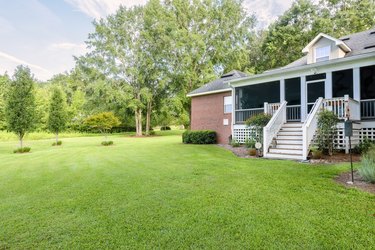
Grass burn is a sign the roots are stressed, and while that can be the result of too much sun exposure or poor drainage, it's also commonly caused by an excess of nitrogen or mineral salts in the soil. Fast-release fertilizers are a common source of nitrogen and mineral salts, and using too much can burn large patches of lawn. Animal urine is also a source of nitrogen, and it causes random brown patches over an otherwise green and healthy lawn.
Because the grass is stressed, one treatment for burnt grass means water and lots of it. The roots need to absorb it, and the soil needs to be flushed out and cleansed. If you act quickly, the grass can recover in a week or so, but if you wait too long and the roots die, there's little recourse but to sow new seed or lay more turf.
Video of the Day
Video of the Day
Tip
Burnt grass needs plenty of water, and to avoid stress, you should stay off the lawn and refrain from mowing until the grass recovers.
Treating Chemically Burnt Grass
If your grass is burnt because you overdid the lawn fertilizer or left your pet alone in the yard, the best way to flush the chemicals out of the soil is to water deeply every day until the grass turns green. Grass normally needs about an inch of water per week, but to heal burnt grass, you may need to water as much as an inch per day. The water needs to sink deep into the soil and reach the roots, which are often as deep as 5 or 6 inches below the surface. But it's also essential that the soil drains well, because the buildup of water to the point of sogginess can cause grass roots to rot.
If a large area is burnt, you may find it difficult to water by hand, and you may need to deploy a sprinkler. To ensure the lawn gets watered at regular intervals, you might want to consider connecting the garden hose to a timer and programming the timer to come on in the early morning so the water has a chance to soak in before the sun comes out and bakes it off. Use a craft stick or a pipe cleaner to check the depth of moisture in the soil and set the run time long enough to moisten to a depth of at least 5 inches.
Sun-Parched Grass Also Needs Water
If your grass has been burnt by a spell of hot, dry weather, it has a good chance of recovering with regular watering, and you'll want to do this in the early morning or late evening. It may look terrible but don't assume it's dead until you've deep watered regularly for a week or so. Although you don't need to flush chemicals from the soil, you do need to get water to the roots, so use the same watering regimen you would use for chemically burnt grass.
When grass gets parched by the sun, the soil often becomes compacted, which prevents water from soaking in and deprives the roots of oxygen. Running over the lawn with a core aerator helps remedy this by loosening the soil and providing pockets into which water can seep. Refrain from mowing and stay off the grass as much as possible until it recovers and begins to turn green.
You May Need to Reseed
When burnt grass doesn't respond to watering, it's because the roots have died, and in that case, you'll probably want to reseed the burnt areas. If the burning was caused by chemicals, it's important to continue the watering regimen for at least a week to flush out the chemicals before you sow new seed.